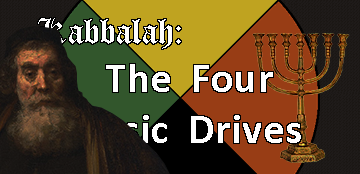



The sephiroth Malkhut is the earth sphere at the base of the Kabbalistic tree.

Malkhut is the seat of four basic drives1*. It's visualisation is a circle divided diagonally into four segments. These are coloured: yellow clay, rust, olive green and living black.
The four drives are:
1. Earth: SURVIVAL — self-preservation, food, shelter, physical security.
2. Fire: SOCIAL/SEXUAL — interaction & communication with other entities (people, plants, animals etc.) including love, social interactions, family life, physical sex, art.
3. Water: SELF ESTEEM — to feel good about ourselves. This can only come from the feedback we receive from our interactions.
4. Air: SELF KNOWLEDGE — to be self-aware; comprehend (not a purely intellectual concept): who, what, where we are; our purpose; where we fit in the natural and social scheme of things.
These are not logical propositions that can be proved or disproved. They are a schema proposed as a tool for organising our perceptions of a natural phenomenon. Like Plato's Theory of Forms, it is a proof by 'inference to the best explanation'. The ultimate test is the usefulness of the schema as a tool in our journey.
I was introduced to the concept of Four Basic Drives through private lectures in the 1970s and later in a publication by John Burke1*. There seemed to be such an intuitive clarity in this schema that I presumed it was a canon of modern psychology.
An internet search for The Four Basic Drives brought up The Four Fs of evolutionary psychology2*: fighting, fleeing, feeding and mating; and the four biological motivations underlying human nature: acquiring, bonding, learning, and defending.3*
The schema of the Four Fs and the Four Biological Motivations are quite flat and one-dimensional and illustrate how a ruling episteme, which today is characterised by physicalism and empiricism, set the conditions of possibility of scientific knowledge.
1. Burke, John 1978, The Dawn of Ra: internal alchemy, private printing, Sydney, p.16 Back
2. Wikipedia, Four Fs (evolution) Back
3. Nohria and Lawrence, Driven: How Human Nature Shapes Our Choices, Wiley, 2002 Back